TLDR; The best paint for hydro dipping is Marabu Marble Paint! 🏆
Keep reading to learn WHY this paint is the easiest to use and best choice for your hydro-dipping projects.
Before that, here’s a fun fact you may not know: hydro dipping is actually an ancient art form.
If you traveled back in time to 900s Japan, you’d see craftsmen marbling papers with silver and gold ink. Many think these old marbled papers were made with ink floating in liquid—just like the modern-day craft.
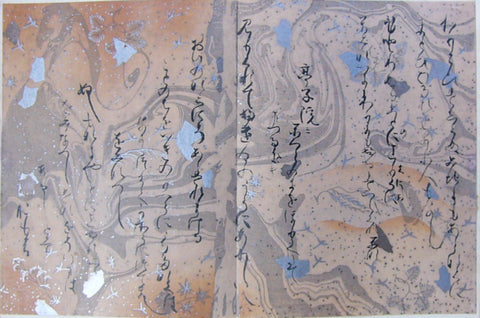
Later on, marbled paper popped up in China, India, the Middle East, and Europe, before developing into the method we use today, which uses modern-day paint.
But what kind of paint is best? Well, that really comes down to what you want. Below, we’ll share the pros and cons of the four major paint types so you can make your own decision.
What’s the Best Paint for Hydro Dipping?
You’re ready to start hydro-dipping your own cups, phone cases, or other items to get that signature marbled look. Now you’re wondering, “What kind of paint should I get?”
Well, as a licensed seller of hydro dip paints, we certainly have some opinions on the topic!
Depending on who you talk to, crafters will generally recommend one of the following types:
- Spray Paint
- Marble Paint
- Acrylic Paint
- Enamel Paint
All can be used for hydro dipping, but with some caveats. And personally, we think there’s a clear winner here—which we’ll explain in a moment.
But first, let’s talk about spray paint.
Spray Paint - Easy to Use, But With Safety Precautions
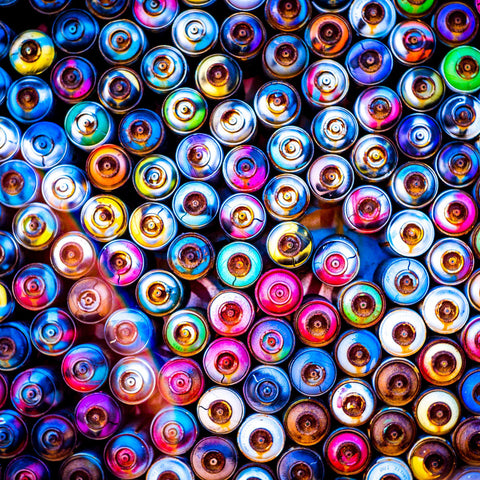
If you search for hydro-dipping paint on Google, you’ll see a lot of results promoting spray paint as the best choice.
How it works: Simply spray the paint into water and they’ll float on the surface, ready for dipping. You must use an oil-based or synthetic spray paint, not a water-based spray paint.
What materials you can use it with: Spray paint sticks to just about anything, including plastic, metal, fabric, wood, glass, ceramic, and more.
Pros: It’s easy to spray into the water, it shows up well on any base color, and the paint dries quickly after removing from the water.
Cons: Spray paint contains toxic chemicals that are released into the air when working. It’s important to work in a well-ventilated room or outside, use a respirator, and stay away from other people when using these paints.
Popular brands: Rust-Oleum, Krylon, One Hit Wonder
Our take: Spray paint can work, but you need to take serious safety precautions while using it. Plus, it’s not great for the environment.
That’s why we recommend the next option, marble paint, which is designed specifically for this type of crafting.
Marble Paint - Safe & Easy to Use

Marble paint is just as easy to use as spray paint, but without the safety hazards that come with aerosol sprays.
How it works: Drop paints directly into water, and they’re ready for dipping!
What materials you can use it with: Marble paint works with a variety of surfaces, including acrylic, glass, metal, wood, fabric, wax, paper, and more.
Pros: No chemicals being sprayed into the air like with other methods. Easy to use and floats on water naturally.
Cons: Paints may not show up as well on dark-colored surfaces, so it’s recommended to use a white sublimation tumbler or powder-coated tumbler or prime a stainless steel tumbler with spray paint or a brush-on primer before dipping.
Popular brands: Marabu Marble Paint
Our take: Marble paint brings the best of both worlds—it’s super easy to use but doesn’t harm your body or the environment. And if you buy powder-coated tumblers, it’s as easy as swirling the paint and dipping!
👉Discover how to hydro dip a camper’s mug using marble paint with our step-by-step tutorial.
Acrylic Paint - OK Method, Requires Borax
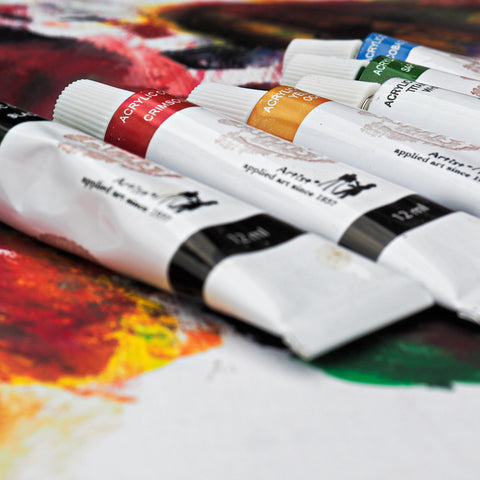
Yes, acrylic paint can work for hydro dipping, if you have some lying around and want to get rid of it. But it requires some modifications.
How it works: Acrylic paint is too heavy to float on water, so you’ll need to thicken the water with borax before using it.
What materials you can use it with: Acrylic paint can stick to almost anything, including metal, fabric, glass, wood, and most other surfaces, but not plastic. You might get better results with a primer applied first.
Pros: Easy to buy—you may already have it at home! Dries quickly. Non-toxic.
Cons: Requires borax to use for dipping, and won’t stick on some materials well without a primer.
Popular brands: Liquitex Basics, Apple Barrel, Winsor & Newton
Our take: Sure, this could work in a pinch, but you’ll get better results with specialized hydro dip paint or spray paint.
Enamel Paint - OK Method, Requires Borax
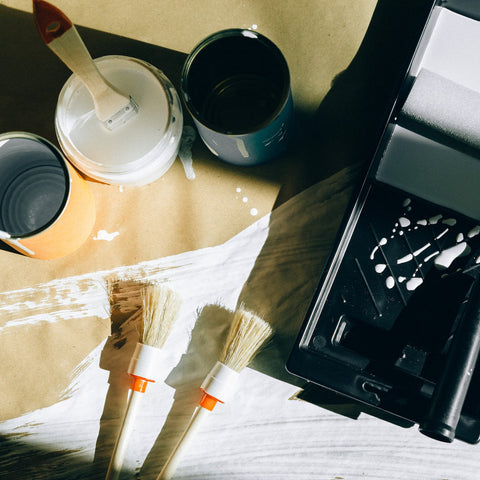
Enamel paints are oil-based paints that can also work for this type of craft, but like acrylic paint, you must use a borax solution to make it work.
How it works: Mix borax into water to create a thicker consistency, then pour enamel paints onto the surface before dipping. Some brands might require you to thin out the paint before using.
What materials you can use it with: Enamel paints can stick to metal, glass, wood, and plastic, but may require a primer.
Pros: May work better for some materials than acrylic paint.
Cons: Enamel paint also contains harmful compounds and requires some safety precautions.
Popular brands: Humbrol
Our take: Yes, you could use enamel paint for hydro dipping, but it pales in comparison to the easy-to-use and non-toxic marble paints and second-best option spray paint.
The Clear Winner? Marabu Marble Paints
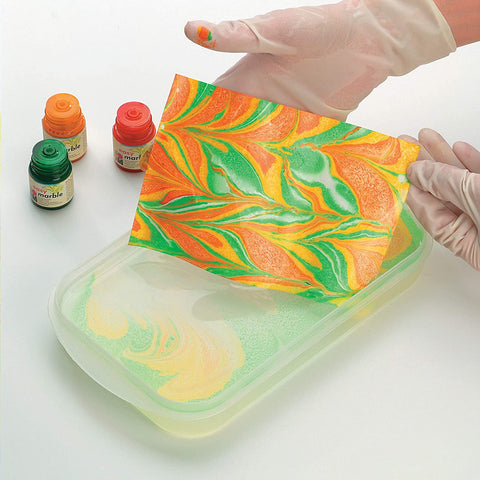
As we see it, marble paints are hands down the best option for your hydro dipping projects. Not only can you breathe easy knowing that harmful chemicals aren’t escaping into the air, but they’re easy to use and you get the same beautiful marbled finish.
Check out our full line-up of Marabu Marble Paints to get your hands on this amazing material.
And if you’d really like to level up your hydro dipping game, pick up our Hydro-Dip Starter Kit with a starter set of tools, 6 colors of paint, Marabu’s Gloss Aqua Varnish for finishing the dipped item, and several blanks for practice.
Remember, anything you can submerge in water can be dipped! Here are some cool hydro-dipped things to inspire your next project.
These Vans by Polka Dot Chair:
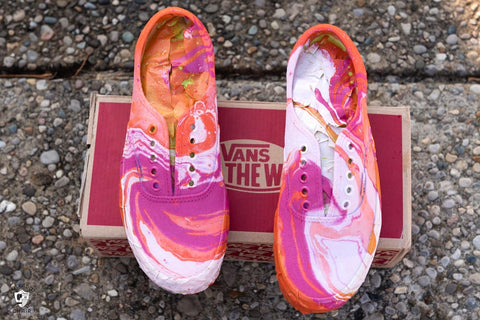
This game controller, dipped by @lukevangogh on Instagram:
And this Airpod case from YitReviews:
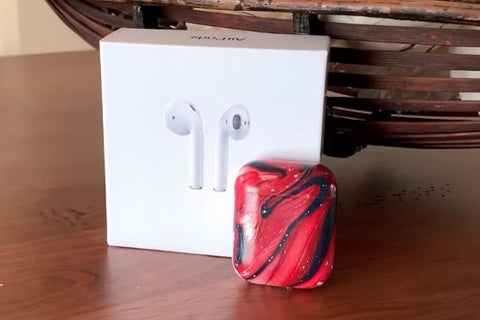
Now the question is… What will YOU make? 🙂
Did you find this article helpful? Leave us a comment below with any questions you may still have about hydro dipping, and we’d love to help you find an answer. 👇
And if you’d like to connect with a community of crafters, join our Official Facebook Group to ask questions and get inspired by others’ creations! We’ll see you there ✨
Frequently Asked Questions (FAQs)
What kind of paint should you use for hydro dipping?
Marble paint is the best choice, since it doesn’t release harmful chemicals into the air. A second choice would be spray paint, which is also easy to use but requires safety precautions.
Should I use a primer before hydro dipping?
Using a primer will certainly make your paint stick better and ensure a long-lasting finish. Or you can pick up a white powder-coated tumbler, for example, that can be dipped right away.
Can you hydro dip with regular paint?
If you’re talking about acrylic paint or oil-based enamel paint, yes, you can. But you’ll need to make a borax solution that allows the paint to float before dipping. Learn more in the article above!












